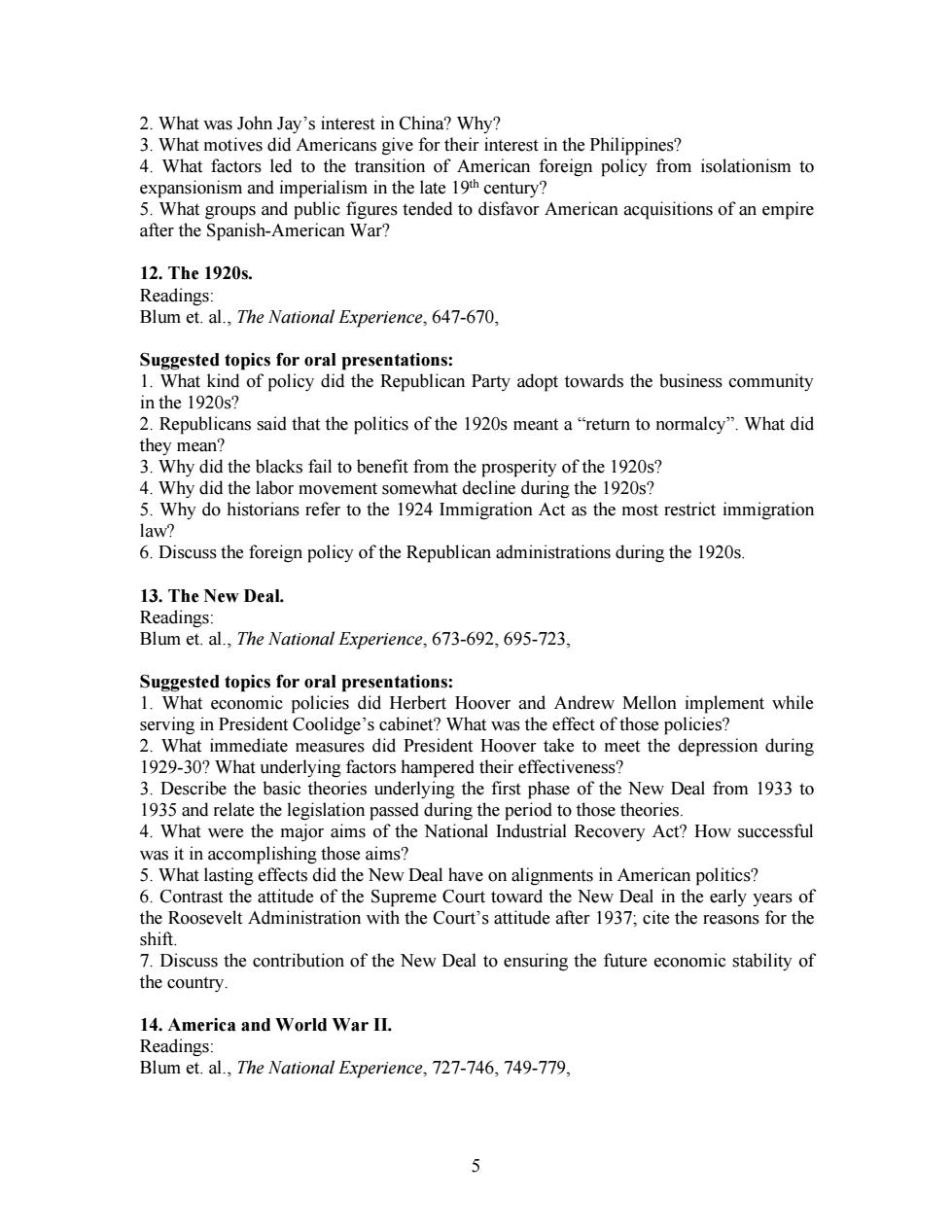正在加载图片...

2.What was John Jay's interest in China?Why? 3.What motives did Americans give for their interest in the Philippines? 4.What factors led to the transition of American foreign policy from isolationism to expansionism and imperialism in the late 19th century? 5.What groups and public figures tended to disfavor American acquisitions of an empire after the Spanish-American War? 12.The1920s. Readings: Blum et.al.,The National Experience,647-670, Suggested topics for oral presentations: 1.What kind of policy did the Republican Party adopt towards the business community in the 1920s? 2.Republicans said that the politics of the 1920s meant a"return to normalcy".What did they mean? 3.Why did the blacks fail to benefit from the prosperity of the 1920s? 4.Why did the labor movement somewhat decline during the 1920s? 5.Why do historians refer to the 1924 Immigration Act as the most restrict immigration law? 6.Discuss the foreign policy of the Republican administrations during the 1920s. 13.The New Deal. Readings: Blum et.al.,The National Experience,673-692,695-723, Suggested topics for oral presentations: 1.What economic policies did Herbert Hoover and Andrew Mellon implement while serving in President Coolidge's cabinet?What was the effect of those policies? 2.What immediate measures did President Hoover take to meet the depression during 1929-30?What underlying factors hampered their effectiveness? 3.Describe the basic theories underlying the first phase of the New Deal from 1933 to 1935 and relate the legislation passed during the period to those theories. 4.What were the major aims of the National Industrial Recovery Act?How successful was it in accomplishing those aims? 5.What lasting effects did the New Deal have on alignments in American politics? 6.Contrast the attitude of the Supreme Court toward the New Deal in the early years of the Roosevelt Administration with the Court's attitude after 1937;cite the reasons for the shift. 7.Discuss the contribution of the New Deal to ensuring the future economic stability of the country. 14.America and World War II. Readings: Blum et.al.,The National Experience,727-746,749-779. 55 2. What was John Jay’s interest in China? Why? 3. What motives did Americans give for their interest in the Philippines? 4. What factors led to the transition of American foreign policy from isolationism to expansionism and imperialism in the late 19 th century? 5. What groups and public figures tended to disfavor American acquisitions of an empire after the Spanish-American War? 12. The 1920s. Readings: Blum et. al., The National Experience, 647-670, Suggested topics for oral presentations: 1. What kind of policy did the Republican Party adopt towards the business community in the 1920s? 2. Republicans said that the politics of the 1920s meant a “return to normalcy”. What did they mean? 3. Why did the blacks fail to benefit from the prosperity of the 1920s? 4. Why did the labor movement somewhat decline during the 1920s? 5. Why do historians refer to the 1924 Immigration Act as the most restrict immigration law? 6. Discuss the foreign policy of the Republican administrations during the 1920s. 13. The New Deal. Readings: Blum et. al., The National Experience, 673-692, 695-723, Suggested topics for oral presentations: 1. What economic policies did Herbert Hoover and Andrew Mellon implement while serving in President Coolidge’s cabinet? What was the effect of those policies? 2. What immediate measures did President Hoover take to meet the depression during 1929-30? What underlying factors hampered their effectiveness? 3. Describe the basic theories underlying the first phase of the New Deal from 1933 to 1935 and relate the legislation passed during the period to those theories. 4. What were the major aims of the National Industrial Recovery Act? How successful was it in accomplishing those aims? 5. What lasting effects did the New Deal have on alignments in American politics? 6. Contrast the attitude of the Supreme Court toward the New Deal in the early years of the Roosevelt Administration with the Court’s attitude after 1937; cite the reasons for the shift. 7. Discuss the contribution of the New Deal to ensuring the future economic stability of the country. 14. America and World War II. Readings: Blum et. al., The National Experience, 727-746, 749-779